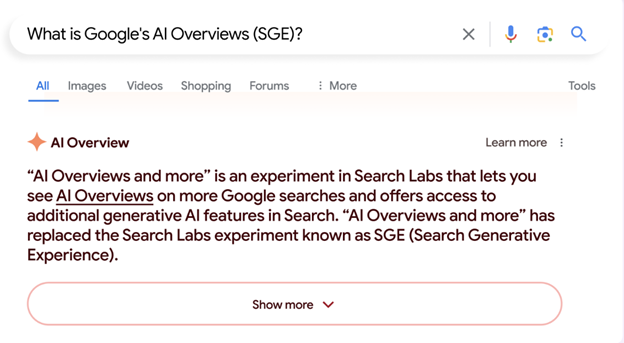Consider the scenario where a potential customer is searching the internet for a product or service, and the top results are exactly what they need. This visibility is not coincidental but a result of these advanced search engines and businesses effectively leveraging effective SEO practices that match online trends and user needs. Understanding and implementing these online trends can position your business prominently in search results, ensuring you capture the attention of your target audience.
Staying updated with the latest SEO trends is crucial for maintaining and improving search rankings. As algorithms become more sophisticated and user behavior shifts, understanding the nuances of SEO is more important than ever. Businesses that adapt to these changes can benefit from increased visibility, higher traffic, and ultimately, more conversions.
In this Blog post we will discuss the latest SEO trends for 2024 and which of them can benefit your business to achieve its goals online.
Video SEO
With the rise of platforms like YouTube and TikTok, video content continues to be an essential tool. Optimizing video content for search engines involves using relevant keywords in titles, descriptions, and tags, as well as ensuring high engagement rates.
Video marketing statistics show that 95% of consumers retain information better when they watch a video than when they read text. It also shows that video content is taking over the web traffic by 82.5% in 2023. Video marketing is an essential approach for all businesses to expand their online presence and empower their performance on different social media platforms.
To make your Youtube videos rank on Google you can follow these 5 simple steps:
- Discover High-Traffic Topics: Research and identify subjects that attract significant viewer interest and have manageable competition. Utilize tools such as Google Trends, YouTube Analytics, and tools such as Ahrefs and YouTube Keyword Tool to uncover topics that resonate with your audience. Prioritizing popular and relevant themes enhances your video’s discoverability.
- Create an Optimized Video: Ensure your video is tailored for both YouTube and Google search. This involves crafting an engaging title with pertinent keywords, providing a comprehensive description, and incorporating relevant tags. Additionally, create video content that captivates your audience, retains their attention, and encourages interaction.
- Correct the Subtitles: Accurate subtitles broaden your video’s accessibility and boost its SEO. Since YouTube’s auto-generated subtitles often contain mistakes, it’s essential to review and amend them. Well-crafted subtitles can also help your video appear in search results for related inquiries.
- Design an Attractive Thumbnail: An appealing thumbnail can increase your video’s click-through rate. Create a custom thumbnail that stands out and accurately reflects your video’s content. Use vibrant colors, clear text, and high-quality images to make your thumbnail more compelling.
- Include Timestamps: Adding timestamps to your video description enhances user experience by allowing viewers to skip to specific segments of the video. This not only makes your content more user-friendly but also signals to search engines that your video is well-organized and thorough, potentially improving its ranking.

Video SEO helps businesses reach their target audience by making videos more discoverable on search engines and social media platforms. Another marketing statistic shows that video content can increase your organic traffic by 157%, boost your conversion rate by 80%, and improve your brand recall by 95%! Making video SEO an essential component of any comprehensive SEO strategy in 2024.
Understanding Google AI Overviews
Google AI Overviews are brief, AI-generated summaries of search results that offer a comprehensive and quick understanding of a specific topic. These overviews synthesize information from multiple websites, ensuring users receive the best answer to what they look for.
Utilizing Google’s Gemini language model, AI Overviews access extensive data to guarantee accuracy and relevance. By integrating insights from various sources, they present a more complete picture compared to traditional search snippets. Google’s AI Overviews use Knowledge Graph, which helps to organize information and provide relevant webpage links in response to search queries

How Google Overviews Work
Google AI Overviews use artificial intelligence to gather and summarize information from various web pages. This gives users a quick, clear understanding of a topic.
Here’s how it works:
- Data Collection: AI scans multiple websites for relevant information.
- Summary Creation: It combines the data into a brief summary.
- Personalized Results: The AI tailors the summary to match the user’s search query and intent.
- Display: The summary appears in the search results, offering a quick overview without needing to click through to multiple sites
This process ensures users get accurate, comprehensive information quickly.

Key features of Google AI Overviews include:
- Customizable Overviews: Users can adjust the complexity of the language or include more details.
- Handling Complex Queries: The AI can reason through multi-step questions.
- Planning Assistance: It aids in organizing plans for activities such as meals and vacations.
- Categorized Results: Search results are organized under AI-generated headings for easy inspiration.
- Video-Based Assistance: Users can ask questions with video for troubleshooting help.
Google’s system automatically decides when to show AI Overviews by assessing the user’s search query and intent. These summaries appear in search results when it’s determined that the user is seeking a quick and thorough understanding of information from various sources.
Strategies for Optimizing for AI Overviews in Google Search:
- Create Highly Specific Content: Ensure your content is detailed and precisely addresses the topic, use long-tail keywords and complete answers to users’ queries This helps the AI accurately extract relevant information and increase the chance that your content is included in AI Overviews.
- Build Links to Establish Trust and Authority: Use internal and external links to reputable sources to build credibility. Links act as signals of trust and authority, helping AI determine the reliability of your content and potentially improving its inclusion in overviews. learn more about Backlinks Building in this blog post.
- Implement Structured Data: Use structured data markup to organize and validate your content. Structured data helps AI understand and process your content more effectively.
- Utilize Multimedia and Optimize for Voice Search: Incorporate multimedia elements and optimize your content for voice search queries. Multimedia and voice search optimization can enhance user engagement and improve your content’s chances of being featured in AI Overviews.
- Continuously Monitor and Adapt to AI Overview Trends: Regularly review how AI Overviews impact your search rankings, check what keywords have AI Overview results and what not, and adjust your strategies accordingly. Staying updated with AI Overview trends allows you to refine your content and SEO tactics, ensuring better search engine rankings over time.
Matching Search Intent is Vital
Search intent, or user intent, is the purpose behind a user’s search query, whether they’re looking for information, making a purchase, or seeking a specific website. Understanding and matching search intent has become paramount, especially with Google’s updated quality rating guidelines.
It is very important to understand users’ intent and create content that matches their needs to help attract the right users to your website or product, thus driving more relevant traffic to your site, reducing bounce rate and increasing page clicks.
Identifying User Intent:
To optimize for search intent, start by thoroughly researching and understanding the different types of intent—informational, navigational, transactional, and commercial investigation.

You can identify search intent by doing the following:
- Analyze Search Queries: Use tools like Google Analytics and Search Console to examine search queries that bring users to your site. Look for patterns and common themes.
- Review SERP Features: Analyze the search engine results pages (SERPs) for your target keywords. Note the types of content that rank well, such as articles, videos, or product pages.
- Use Keyword Research Tools: Use tools like Ahrefs Keyword Explorer or Semrush Keyword Research tools to find relevant keywords. These tools can provide insights into the search volume, keyword difficulty, and the intent behind keywords.

How to Optimize for User Intent?
- Create Relevant, High-Quality Content: Ensure your content answers users’ questions comprehensively and provides value to meet their specific search intent.
- Use Intent-Driven Keywords: Incorporate keywords that reflect the user’s intent throughout your content, meta descriptions, and headers to improve relevance.
- Provide Clear Navigation Paths: Design your website layout and navigation to make it easy for users to find the information they need or complete desired actions. Defining your website’s information architecture strategically is key.
- Include Compelling Calls to Action: For transactional or commercial intent, ensure your calls to action are clear, persuasive, and easy to follow.
Leveraging Author Entities
Author entities refer to the recognition and association of an individual author with the content they create, enabling search engines like Google to understand the credibility and expertise of the author. From Google’s perspective, establishing author entities is crucial for assessing the trustworthiness and authority of content, especially in an era where AI-generated content is becoming more prevalent. AI-generated content can vary in quality, making it essential for Google to differentiate between human-authored and machine-generated material to ensure accurate and reliable search results.
To leverage author entities for SEO in 2024, consider the following strategies:
- Detailed Author Bios: Include comprehensive author bios on your website, highlighting their expertise and credentials.
- Social Media Profiles: Link to authors’ social media profiles to establish their online presence and authenticity.
- Structured Data Markup: Use schema.org markup to help search engines accurately identify and associate content with the correct author.
- Consistent Author Attribution: Ensure that all content is consistently attributed to the correct author across various platforms and publications.
- Active Online Presence: Encourage authors to participate in industry discussions, guest posts, and interviews to enhance their visibility and credibility.
- Quality Content Creation: Focus on producing high-quality, original content that showcases the author’s expertise, distinguishing it from generic AI-generated content.
By emphasizing these points, websites can enhance their content’s authority, leading to higher rankings and increased trust from both search engines and users.
Optimizing Based on User Signals
User signals play a crucial role in how Google ranks content, often prioritizing user reactions over the content itself. This shift means that search engines are increasingly focused on understanding user satisfaction and engagement rather than just analyzing the depth of the content. For instance, Google has developed sophisticated systems to gauge how users interact with a page, looking for indicators of positive sentiment. This evolution highlights that successful SEO strategies must prioritize user needs and expectations beyond traditional content creation.
To effectively optimize for user signals, consider these strategies:
- Monitor Engagement Metrics: Track key indicators like time on page, bounce rate, and user interactions to gain insights into how users engage with your site using Google Analytics . Use this data to refine your content and layout.
- Align Content with User Intent: Ensure your content directly addresses what users are searching for. If they seek quick answers, present them clearly rather than burying them in lengthy text.
- Incorporate Visual Elements: Use engaging visuals like videos and infographics to enhance user experience, as these can capture attention and encourage deeper interaction.
- Encourage User Interaction: Integrate features like comment sections, polls, and quizzes to promote user engagement and foster a community around your content.
By focusing on these aspects, you can create a more engaging user experience that signals to Google that your content is valuable and relevant.
Social Networks and AI Chats: Emerging Competitors to Search Engines
As social networks and AI chat platforms gain traction, they present a new form of competition to traditional search engines like Google. However, changing user behavior is challenging; many still rely on Google for serious queries due to its established reliability and comprehensive search results. Unlike social media platforms, which often prioritize engagement over accuracy, Google consistently delivers trustworthy information.
Recommendations for Adapting to Alternative Search Methods:
- Leverage Social Media SEO: Create shareable content and optimize social media profiles to improve visibility on platforms like LinkedIn, Instagram, Facebook, and TikTok, where users often search for information.
- Engage with AI Chatbots: Integrate AI chat solutions on your website to provide instant responses to common queries, enhancing user experience and keeping visitors engaged.
- Diversify Content Formats: Utilize various content types, including videos, infographics, and podcasts, to cater to different platforms and user preferences, increasing chances of discovery.
- Build a Strong Brand Presence: Actively engage with your audience on social media to foster community and brand loyalty, ensuring your content is shared and promoted organically.
- Focus on Local SEO: Optimize for local searches by ensuring your business information is accurate across platforms like Google Business Profile (GBP), as many users turn to social media for local recommendations.
- Encourage User-Generated Content (UGC): Prompt customers to share their experiences on social platforms, enhancing authenticity and improving visibility through social proof. Check out The Gray Dot Company’s guide on generating UGC here.
- Monitor Trends and Adapt: Stay informed about emerging trends in search behaviors and social media algorithms, adjusting your strategies accordingly to remain relevant.
- Utilize Analytics Tools: Use analytics to track where your traffic comes from and how users interact with your content, allowing you to refine your approach based on performance insights. Your first step should be to define clearly your Key Performance Indicators (KPIs) and identify the appropriate metrics to track and measure.”
To adapt to these alternative search methods, businesses should optimize content for various platforms, engage with users on social media to build brand presence, and ensure their information is accessible across multiple formats. This multifaceted approach can help maintain visibility as user behaviors evolve.
Marketers Use of AI Tools to Save Time
Since the emergence of AI, marketers increasingly turn to AI tools to boost operational efficiency and scale. By automating tasks like data analysis, content creation, and customer segmentation, AI allows teams to focus on strategic initiatives. For instance, AI-driven analytics platforms provide real-time insights, while chatbots enhance customer engagement without extensive human resources. However, this reliance on AI also presents threats, such as content homogenization and diminished creativity, as outputs may become formulaic and lack originality. Additionally, AI-generated content may struggle to resonate with audiences seeking authentic, human-driven narratives.
To balance these advantages and risks, marketers should use AI as a complement to human creativity, ensuring content remains engaging while enhancing productivity and scalability.
How to Use AI to Boost Scale?
AI serves as a versatile writing assistant with various capabilities that can significantly enhance scalability. Here are some effective ways to leverage AI:
- Editing Assistance: Utilize AI to refine drafts by applying a consistent voice and tone throughout your content.
- Information Summarization: Ask AI to condense complex information, making it easier to digest.
- Conciseness: Use AI to shorten existing copy, ensuring clarity without losing essential points.
- Bullet Point Conversion: Transform lengthy paragraphs into concise bullet points for easier readability.
- Data Organization: Have AI create tables from existing information, making data presentation more structured and accessible.
- Outline Creation: Generate top-level outlines to organize content ideas and improve overall structure.
- Content Ideas Planning: Use AI to help you create your content plan. It can analyze trending topics, audience interests, and competitive content to suggest relevant themes and formats.
By integrating these AI functionalities, marketers can streamline their processes and achieve greater efficiency in content creation.
EEAT: First Hand Experience
In 2024, understanding the concept of EEAT (Experience, Expertise, Authoritativeness, Trustworthiness) is essential for optimizing content and improving your site’s visibility on Google.
EEAT stands for:
- Experience: Refers to the firsthand experience of the content creator. Google values content created by individuals with real-life experience in the subject matter.
- Expertise: This indicates the knowledge and skill level of the content creator. High expertise is crucial for topics that require specialized knowledge, particularly in fields like health and finance.
- Authoritativeness: This assesses the overall credibility of the website and its authors. Authoritative sources are recognized and respected within their respective fields.
- Trustworthiness: This aspect evaluates how reliable the content and the website are. Trust signals include secure connections, positive reviews, and clear contact information.
How Google Uses EEAT:
Google employs EEAT as part of its algorithm to determine the quality of content on websites. High EEAT scores help content rank better in search results, especially for YMYL (Your Money Your Life) topics, where misinformation can lead to serious consequences.
Utilizing EEAT to Optimize Your Content:
- Create High-Quality Content: Focus on producing in-depth, well-researched articles that provide real value to your audience. Use data and examples to support your claims.
- Showcase Author Credentials: Clearly display the qualifications and expertise of your authors. Include bios that highlight their experience related to the topic.
- Build Authoritative Backlinks: Gain links from reputable sites within your industry. Collaborate with experts and establish relationships that enhance your site’s authority.
- Enhance Trust Signals: Ensure your website is secure (HTTPS), includes clear contact information, and showcases customer reviews or testimonials to build trust with visitors.
- Update Content Regularly: Keep your content fresh and relevant. Regular updates signal to Google that your site is active and committed to providing accurate information.
Core Web Vitals
In 2021, Core Web Vitals—comprising Largest Contentful Paint (LCP), First Input Delay (FID), and Cumulative Layout Shift (CLS)—became key Google ranking factors, emphasizing the importance of user experience (UX) in website assessments. The recent announcement from Google’s Chrome team about replacing FID with the Interaction to Next Paint (INP) in March 2024 reflects a commitment to even more accurately measure responsiveness. This enhancement will better gauge the time from user interaction to visual update, providing a clearer view of the actual user experience.
To optimize these metrics, website owners should compress and modernize media files, minimize JavaScript execution, reserve space for dynamic elements to prevent layout shifts, and prefer CSS for animations.

Tools for Monitoring and Optimization:
- Google PageSpeed Insights: Provides a detailed analysis of your website’s performance, including Core Web Vitals, and offers specific suggestions for improvement.
- Lighthouse: An open-source tool integrated into Chrome DevTools that audits performance, accessibility, and SEO, including Core Web Vitals.
- Search Console: Google’s Search Console offers a Core Web Vitals report, highlighting issues and providing insights into how your website performs over time.
By improving these aspects, you enhance UX, which not only retains visitors but also boosts your site’s quality signals to Google, potentially elevating search rankings and visibility.
Voice Search Optimization
This evolution in search behavior is driven by the convenience and speed of spoken queries, allowing users to multitask and access information hands-free.
Here are the key points on optimizing for voice search in 2024:
Use Natural Language and Long-Tail Keywords:
- Conversational Queries: Voice search queries tend to be more conversational and natural. Instead of typing “best pizza NYC,” a user might say, “Where can I find the best pizza in New York City?”
- Long-Tail Keywords: Focus on long-tail keywords that reflect how people naturally speak. This can help your content align better with voice search queries, improving your chances of ranking.
Create Concise and Informative Content:
- Direct Answers: Provide clear and direct answers to common questions related to your industry. For instance, if you’re a restaurant, include content that answers questions like “What are the best dishes at your restaurant?” or “What are your operating hours?”
- Featured Snippets: Aim for your content to be featured in snippets, as these are often the answers provided by voice assistants. This can be achieved by using structured data and schema markup to highlight important information.
Ensure Mobile-Friendliness:
- Responsive Design: Make sure your website is fully responsive and provides a seamless experience across all devices, especially smartphones, as many voice searches are conducted on these devices.
- Fast Load Times: Optimize your website’s load times by compressing images, using a content delivery network (CDN), and minimizing the use of heavy scripts. Faster load times improve user experience and are favored by search engines.
Optimize for Local Search:
- Local Listings: Keep your Google Business Profile (GBP) up to date with accurate information. Voice searches often have a local intent, such as finding nearby services.
- Local Keywords: Incorporate local keywords into your content, such as city names and neighborhood identifiers, to capture voice search traffic from users looking for local businesses.
Implementing these strategies can help improve your website’s visibility in traditional SERP and voice search results, making it easier for users to find and interact with your content. Having your content optimized for Google’s traditional search means it’s also optimized for voice search.
Why do we care about trends?
The digital world is constantly changing, and what works today may not work tomorrow. Staying informed about the latest SEO trends is essential for adapting strategies and maintaining a competitive edge.
Implementing these trends requires continuous testing, learning and adaptation. By integrating AI-driven approaches, optimizing video content, focusing on Core Web Vitals, and utilizing advanced tools, you can enhance your SEO strategy and achieve better results.
At SEO Transformer, our SEO experts can join you in your journey of optimizing your website to improve its online presence by offering a full website audit and up to date SEO strategies that help you achieve your online goals with continuous analysis and ongoing performance follow-up. Partner with us today!









